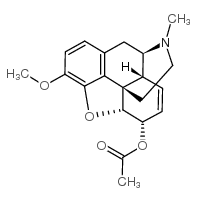6-O-Acetyl Codeine

6-O-Acetyl Codeine structure
|
Common Name | 6-O-Acetyl Codeine | ||
|---|---|---|---|---|
| CAS Number | 6703-27-1 | Molecular Weight | 341.40100 | |
| Density | 1.3 g/cm3 | Boiling Point | 461.2ºC at 760 mmHg | |
| Molecular Formula | C20H23NO4 | Melting Point | 132-134ºC | |
| MSDS | N/A | Flash Point | 232.7ºC | |
| Symbol |


GHS02, GHS07 |
Signal Word | Danger | |
|
Development and validation of a solid-phase extraction gas chromatography-mass spectrometry method for the simultaneous quantification of methadone, heroin, cocaine and metabolites in sweat.
Anal. Bioanal. Chem 392(1-2) , 115-27, (2008) A sensitive and specific method is presented to simultaneously quantify methadone, heroin, cocaine and metabolites in sweat. Drugs were eluted from sweat patches with sodium acetate buffer, followed by SPE and quantification by GC/MS with electron impact ioni... |
|
|
The detection of acetylcodeine and 6-acetylmorphine in opiate positive urines.
Forensic Sci. Int. 95(1) , 1-10, (1998) Acetylcodeine (AC), an impurity of illicit heroin synthesis, was investigated as a urinary biomarker for detection of illicit heroin use. One hundred criminal justice urine specimens that had been confirmed positive by GC/MS for morphine at concentrations > 5... |
|
|
Detection of non-prescription heroin markers in urine with liquid chromatography-atmospheric pressure chemical ionization mass spectrometry.
J. Anal. Toxicol. 25(6) , 431-8, (2001) The planned introduction of a prescription heroin program in Germany created a need for differentiation between non-prescription and prescribed diamorphine use. The following substances were chosen as markers of non-prescription heroin: acetylcodeine (AC); it... |
|
|
Opiate concentrations in hair from subjects in a controlled heroin-maintenance program and from opiate-associated fatalities.
J. Anal. Toxicol. 29(5) , 345-52, (2005) One month before (T-1) and 12 months after (T12) controlled intravenous administration of pharmaceutical heroin-HCl (10-1000 mg/d) in the context of a heroin-maintenance program, concentrations of opiates in head hair were determined (n = 46), using a validat... |
|
|
Evaluation of acetylcodeine as a specific marker of illicit heroin in human hair.
J. Anal. Toxicol. 22(6) , 425-9, (1998) In addition to acetylmorphine (6-AM), acetylcodeine (AC) has been suggested as a marker for the use of illicit heroin. Because no procedure was available for AC testing in hair, a new method was developed for the simultaneous identification and quantitation o... |
|
|
Cocaine and opiate concentrations in hair from subjects in a heroin maintenance program in comparison to a methadone substituted group.
Int. J. Legal Med. 123(5) , 363-9, (2009) One month before (T-1) and 12 months after (T12) controlled i.v. administration of pharmaceutical heroin-HCl (10-100 mg/day) in the context of a heroin maintenance program (HMP), concentrations of opiates and cocaine as well as its metabolites were determined... |
|
|
Acetylcodeine as a marker of illicit heroin abuse in oral fluid samples.
J. Anal. Toxicol. 30(6) , 370-4, (2006) A method was developed using liquid chromatography linked to atmospheric pressure ionization-tandem mass spectrometry (LC-MS-MS) for the measurement of the opiates, morphine, codeine, 6-monoacetylmorphine (6-MAM), acetylcodeine (AC), and heroin in oral fluid ... |
|
|
Acetylcodeine, an impurity of illicitly manufactured heroin, elicits convulsions, antinociception, and locomotor stimulation in mice.
Drug Alcohol Depend. 65(1) , 37-43, (2001) Acetylcodeine is one of the major impurities present in illicitly manufactured heroin (diacetylmorphine). Data on its pharmacology and toxicology are limited and its ability to alter the toxic effects of diacetylmorphine is not known. The first objective of t... |
|
|
Programmable temperature vaporizer applications in an high-resolution gas chromatographic method for the quantitation of impurities in illicit heroin.
J. Chromatogr. A. 466 , 384-9, (1989)
|
|
|
Oral fluid results compared to self reports of recent cocaine and heroin use by methadone maintenance patients.
Forensic Sci. Int. 215(1-3) , 88-91, (2012) Although self reports of illicit drug use may not be reliable, this information is frequently collected and relied upon by national drug surveys and by counselors in drug treatment programs. The addition of oral fluid testing to these programs would provide o... |